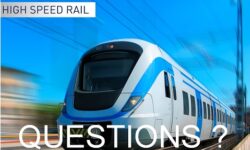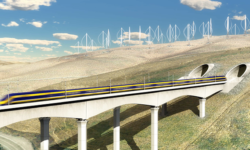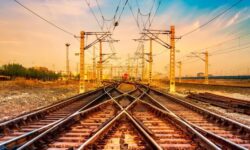Sydney-Melbourne, via Wagga Wagga, is the corridor generally preferred by the HSR2 report 2013.
FUTURO has investigated Variations with prefeasibility "google earth" corridor studies. Feasibility studies are still required and strongly recommended.
A) HSR and Containerised Freight concept. A dedicated Two Track System.
- Terminal in Sydney to be in the Homebush Area (for containerised freight and passengers/light freight). The most likely scenario to connect with state planned surface infrastructure direct Underground Metro links to Parramatta, Central, the City Loop and/or the Airports and Main Western Rail Lines.
- Corridor via (generally following the Maldon to Dumbarton line) Douglas Park or a through low level tunnel from Campbelltown to Wollongong and Albion Park to Nowra and Canberra via the Nerriga area. This maximises the capture of population, Southern Highlands, and Goulburn included. This “VARIATION” corridor could also be run with Tilt train at 260Km/hr., giving more flexibility on the track geometry, over the more rigid geometry requirements for a HSR at 320Km/hr.
- The inclusion of the Newcastle to Sydney leg.
- A DIRECT CONNECTION to Canberra with a main station at Fyshwick and cargo rail connections to Canberra Airport.
- A Canberra Cooma Jindabyne Khancoban Ettamogah corridor. Via a 40km approx. tunnel under Mt Kosciuszko.
B) HSR with Containerised Freight and Bulk Freight concept. A dedicated Two-Four Track System.
The proposals in A) would be augmented with another twin track alongside it for Bulk Freight.
However we don't believe a Bulk freight additional two tracks as necessary if all freight is containerised to suit smaller containers to maximum axle loads of 20 tonne net. Due to diminishing coal demends zero emissions target this seems to be the trend.
In Addition a Port Kembla Newcastle corridor would also connect into the Intermodals at Moorebank, Port Enfield. It is understood that the NSW government is deploying the Botany Port to Moorebank.
C) Feasibility Study
The Feasibility Study for the Melbourne – Sydney (with Canberra Loop) can be managed by the Futuro Infrastructure Innovation Group along the "Futuro HSR/FFR Concept Australia" corridor and will involve be a mixture of University, Engineering, Transport, Rolling Stock and Operator Companies inclusive of Federal, State, Regional Development and Local Governments.
- Phase 1. Term of reference for a Feasibility Study (by AACE International standard a +10% to -10% Cost Estimate or Class III).
Phase 1 - Feasibility Study would require a $85 million for a high-speed rail network linking Sydney, Canberra and Melbourne, with a particular focus on the Melbourne-Sydney. The proposed study will identify corridors, estimate construction costs, undertake preliminary geotechnical investigations and utilising all existing Federal, State and Council geotechnical report of the selected corridors and the financial and economic modelling necessary to determine the project’s viability. It is expected to take about 15 months to complete.
The same process will be used in planning the inland heavy freight rail feasibility study to identify reduction of costs and develop a more reliable fast delivery of containers as apart of heavy and/or bulk freight.
Please note that, if deemed necessary during the planning and design phase, high-speed passenger and fast containerised freight trains will operate on separate tracks from heavy freight trains.
- Phase 2. Term of reference for a Control Study (by AACE International standard a +5% to -5% Cost Estimate) or Class II & I).
Phase 2 – Control Study would require a $330 million for a high-speed rail network linking Sydney, Canberra and Melbourne, with a particular focus on the Melbourne-Sydney. The proposed study will identify corridors, estimate construction costs, undertake preliminary geotechnical investigations and utilising all existing Federal, State and Council geotechnical report of the selected corridors and the financial and economic modelling necessary to determine the project’s viability. It is expected to take about 24 months to complete.
The Feasibility Study for the Wagga/Wagga - Brisbane, Inland Rail, will be managed similarly to above by the Futuro Infrastructure Innovation Group with the "Futuro HSR/FFR Concept Australia".
- Phase 1. Term of reference for a Feasibility Study (by AACE International standard a +10% to -10% Cost Estimate or Class III).
Phase 1. The Feasibility Preliminary Study would require a $120 million for a high-speed rail network linking Wagga/Wagga – Brisbane (Inland Route), with a particular focus on the following towns Forbes, Parkes, Dubbo, Goondiwindi, Toowoomba and Ipswich. The proposed study will identify corridors, estimate construction costs, undertake preliminary geotechnical investigations and utilising all existing Federal, State and Council geotechnical report of the selected corridors and the financial and economic modelling necessary to determine the project’s viability. It is expected to take about 18 months to complete.
The same process will be used in planning the inland heavy freight rail feasibility study to identify reduction of costs and develop a more reliable faster delivery of containers. Again: Please note that, if deemed necessary during the planning and design phase, high-speed passenger and fast containerised freight trains will operate on separate tracks from heavy freight trains.
- Phase 2. Term of reference for a Control Study (by AACE International standard a +2-5% to -2-5% Cost Estimate) or Class II & I).
Phase 2 – Control Study would require a $350 million for a high-speed rail network linking Wagga/Wagga – Brisbane (Inland Route), with a particular focus on the Forbes, Parkes, Dubbo, Goondiwindi, Toowoomba and Ipswich. The proposed study will identify corridors, estimate construction costs, undertake preliminary geotechnical investigations and utilising all existing Federal, State and Council geotechnical report of the selected corridors and the financial and economic modelling necessary to determine the project’s viability. It is expected to take about 24 months to complete.
The Feasibility Study for the Sydney – Newcastle - Narrabri will be managed similarly to above by the Futuro Infrastructure Innovation Group with the "Futuro HSR/FFR Concept Australia".
- Phase 1. Term of reference for a Feasibility Study (by AACE International standard a +10% to -10% Cost Estimate or Class III).
Phase 1. The Feasibility Preliminary Study would require a $95 million for a high-speed rail network linking Sydney – Newcastle - Narrabri (Inland Route Connection), with a particular focus on the following towns Forbes, Parkes, Dubbo, Goondiwindi, Toowoomba and Ipswich. The proposed study will identify corridors, estimate construction costs, undertake preliminary geotechnical investigations and utilising all existing Federal, State and Council geotechnical report of the selected corridors and the financial and economic modelling necessary to determine the project’s viability. It is expected to take about 12 months to complete.
The same process will be used in planning the inland heavy freight rail feasibility study to identify reduction of costs and develop a more reliable faster delivery of containers.
Again: Please note that, if deemed necessary during the planning and design phase, high-speed passenger and fast containerised freight trains will operate on separate tracks from heavy freight trains.
- Phase 2. Term of reference for a Control Study (by AACE International standard a +2-5% to -2-5% Cost Estimate) or Class II & I)
Phase 2 – Control Study would require a $280 million for a high-speed rail network linking Wagga/Wagga – Brisbane (Inland Route), with a particular focus on the Newcastle and Narrabri. The proposed study will identify corridors, estimate construction costs, undertake preliminary geotechnical investigations and utilising all existing Federal, State and Council geotechnical report of the selected corridors and the financial and economic modelling necessary to determine the project’s viability. It is expected to take about 22 months to complete.
This second, Control Study (Phase 2. In all three sections) will determine an optimum route alignment, identify patronage levels, develop cost estimates and investigate financing options. Will developed and include for the required cost of Integrated Owner Management Team (IOMT) and include land and buildings acquisition, for which a preliminary figure has been derived at $A10.5B (2023) for the entire route of 3,000 km dual tracks HSR-FFR
Final Design will be administered through an Integrated Owner Management Team (IOMT)
A At 4 years engineering, design and land/building acquisition
The IOMT cost above is the total cost for 3000Km of dual rail HSR/VFT.
In our first leg Melbourne, Canberra, Sydney and Newcastle, the time is around is around 30 months study with a costs of $A6.3B.(2023)
Scope of the Study; Futuro Infrastructure Innovation Group with the "Futuro HSR/FFR Concept Australia" is able to release a full terms of reference for the Feasibility Study and design.
A Closing Note
I am sure there has been some great persons in the pass (eg. Bradfield, Hudson), with grandiose schemes that exemplified the thinking that can transform Australia’s future. In those cases Government has taken the lead.
As many of you know we are endeavouring to push through with the Concept via a Consortia of our Group, which include importantly a mixture of the international companies in HSR technologies.
In discussions on the financing of the project, with some of these company consortia appears not to be a problem and I have had it said that there is some preliminary interest from private institution to invest in our project and we would like very much to hear from any Financial entity if they would like to discuss this project further.
We believe our group has the right mix for the High Speed model by the inclusion of containerised freight and possibly in future, Bulk, that with its the integration of it into the regional areas will allow in itself a revaluation on all land uses along the corridor.
I can’t think of anything better for any political and financial persuasion, to galvanise and give outright confidence to the Australian people at this time. Reforming the Rail Network.
We need funding for Feasibility Studies (FS) and we estimate $85M for the first leg Melbourne – Sydney (with Canberra in line included), it has to to have Federal bipartisan and State Governments support. It could come from the internationals within in our group but in that case there must be a license for the project in place. Either way the Australian Government must take the lead.
For and on behalf of
FUTURO INFRASTRUCTURE INNOVATION GROUP
"FUTURO HSR/FFR CONCEPT AUSTRALIA"
PAOLO GIAMMARCO (Managing Director),
GIANCARLO VIMERCATI (Technical Advisory)



